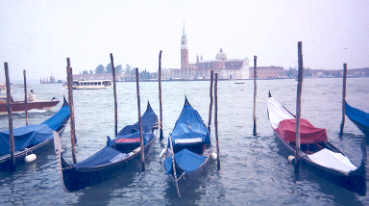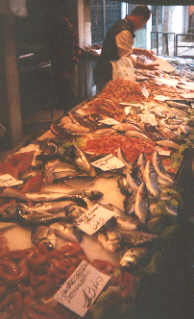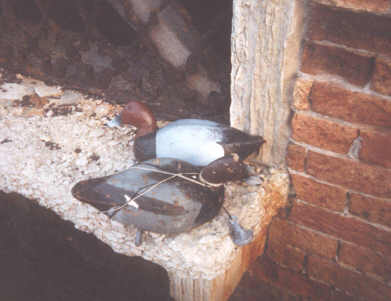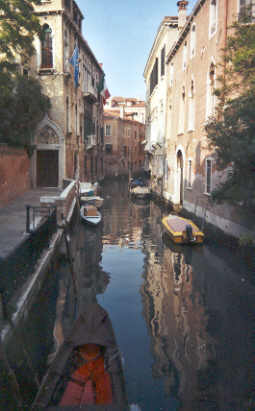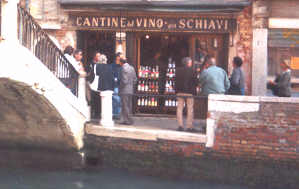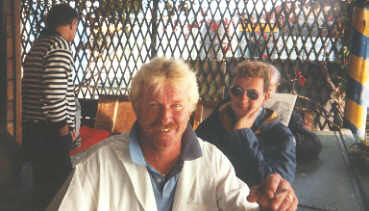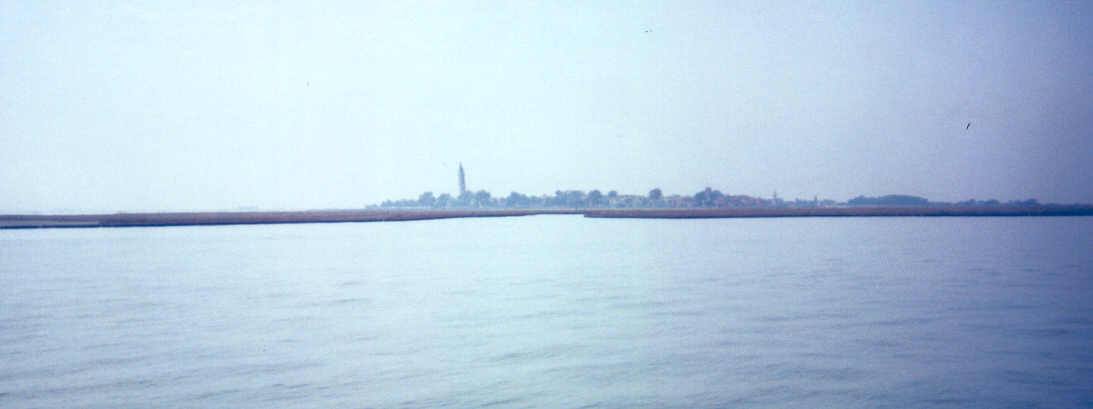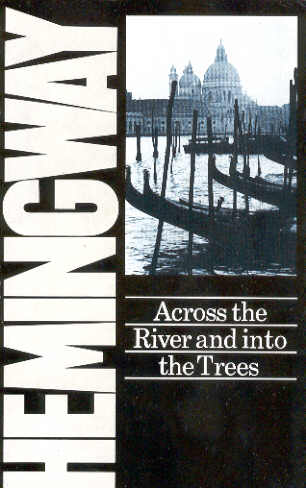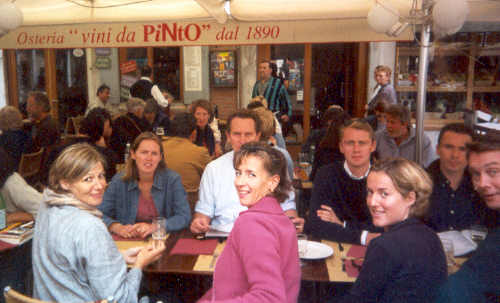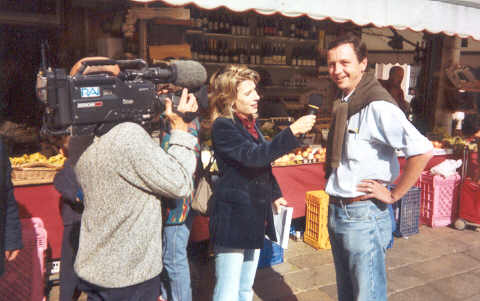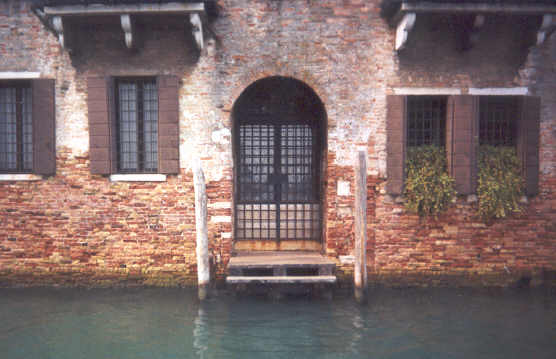|
In search of famous duck hunters in Venice.
The first idea was to check
the Gritti Palace Hotel and the famed Harry's Bar, but with little
hope. Obviously there, no one would display decoys or wear a hunter's
cap to show his passion. The Gritti boasts a unique location -the
terrazza where you can take breakfast or dine is directly on the grand
canal- But something tells me that after Hemingway no one came here to
use this place as a base camp for a duck hunt. Same thing for the
Harry's bar, it all looks very polished now and the prices tell that
the place is more for occasional drinkers -not to say tourists- than
for local hunters to congregate and chat freely.
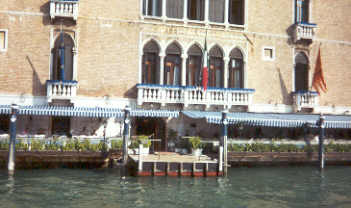
The terrazza
of the Gritti is ideally set on the grand canal
I have said above that I had few hints about Venitian duck huntings.
This is actually not so true as I had read most of the lines written
about the topic in the biographies of Hemingway, or in the history book
of the Harry's Bar written by Arrigo Cipriani. Also an article had been
published in France by Bruno de Cessole in the beautiful outdoors
magazine Jours de Chasse. In turn I spoke with Bruno and
obtained from him the phone number of the barone Alvarito,
actually the very son of the other barone who was Hemingway's
hunting companion in Venice in the late 40's. I hesitated to call him
saying that I was a sportsman and writer in search of information about
Hemingway... -how many people had done this before me ?- but I did and
lost my fears when he answered and suggested that I come at the end of
the afternoon for a short conversation. His father was described in the
novel as a very shy person, and apparently the new barone
inherited the same réserve. As I am also quite shy, the
conversation could have soon turned to a long series of embarrassing
silences but with only a couple of words I understood that hunting is
not for him an occasional winter pass-time but a true passion of
surpassing importance. He explained to me very clearly what the hunting
was like in the post war period and how it is conducted now.
Surprisingly not many changes have occurred -and in fact not many
changes have occurred since the XVIIIth century when Pietro Longhi was
painting his scene di caccia -that can be admired at the
Querini-Stampalia foundation in Venice.
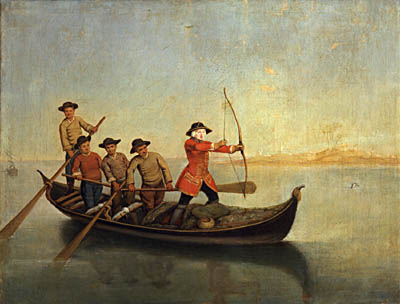
Pietro Longhi's Scene
di caccia from the Querini-Stampalia Web-Gallery
The hunting areas are found all along the seashore from the
estuary of the fiume Pô to the border with Slovenia in
the south of Udine. Between the town of Chioggia and Slovenia, the
deltas of large rivers like the Brenta, Piave, Tagliamento,
Isonzo and others were at the origin of the the many
lagoons. In this area, you are considered to be hunting in the region
of Venice even if many places are situated well outside the city's
lagoon. Most of the estates were originally owned by ancient Venitian
families.
Waterfowl hunting across the ages in the Veneto
region
The barone explains that almost for ever there has been both
an aristocratic and a popular method to hunt the wetlands. The seashore
formed by water pockets and grassy silt banks named barenes has
been stable for many centuries now. Long before the Longhi's
masterpieces these places were huge private estates, occasionally
planted for rice and widely used as semi-wild fisheries. Minnows were
trapped and stocked in the so called valli di pesca and
harvested later after having grown and fed on natural nutriments. The valli
di pesca were -and still are- excellent duck magnets for the
migrating species from north-eastern Europe, but also the local
reproduction of mallard and a few other species is quite good. With the
growing social importance of field sports, the owners of the valli
gradually turned their properties into hunting estates -reducing the
water depth- and the fish production became a minor side activity. The
only difference between the past and today is the fact that the estates
have mainly moved from the hands of the Venitian aristocracy to those
of industrial tycoons from all over Italy. The barone explains that his
own father had split the the huge family valle in Latisana, into
three smaller ones and gradually sold each of them to wealthy
businessmen from Milan or Rome. This is the evolution of these valli
di caccia.
Outside these properties, on the very lagoon, you can still
find huge areas of attractive duck waters where villagers and seamen
-fishers, or boaters like gondoliere- have always been almost
freely hunting waterfowl. There is a big difference between hunting in
the valli and hunting in the lagoon. First, a huge financial
difference, then of course a difference of comfort -the hunters of the valli
still employ many game keepers and boaters. They gather at nice lodges
named casone where a cook is often hired for the hunter's
comfort. The casone is a traditional marsh house with a reed
thatched roof and the comfort inside can be outstanding. Technically it
is also not the same hunt as on the lagoon. Birds reside in the valli,
therefore hunters shoot very few days in hopes of seeing tremendous
quantities of the ducks on each shooting day. In the lagoon on the
other hand, hunters mainly expect pass-shooting at traveling birds.
Only if your outings are frequent can you be assured of hitting the
good days. The hunters of the lagoon shoot from their boats anchored at
some point of the silt banks. Conversely valli hunters use the botte,
described by Hemingway as "The sunken oak hogshead that they used in
the veneto for blinds..." The valli hunt is currently named
caccia in botte.
The barone confirmed that after Hemingway, no or very few
other Americans really came to hunt here. None of the valli
ever operated for paying guests and if you are not invited there is no
way you can shoot there. "Hemingway" -he adds- "was hunting both ways,
the popular and the aristocratic when he was invited by my father like
the day he describes in the novel. But during the winters 48 and 49 he
was an almost permanent guest of the Locanda Cipriani in
Torcello. Cipriani was keeping it open only for him. Some mornings when
he was not working -he was always waking up between 4.00 and 5.00 am to
write- he would hire the services of a local boater who would take him
morning flighting, at oar distance from Torcello".
"I am still also invited at our former valle but I
like very much the popular way to hunt also" -the baron continues. "I
will give you an address were you should go and talk with a team of gondoliere,
who are keen hunters, you should be able to negotiate with one of them
to take you out one morning. I remember Hemingway liked very much these
morning of secluded hunts. You know that very often I saw him in the
very armchair where you are now. He was often coming for a hunters chat
with my father after these days".
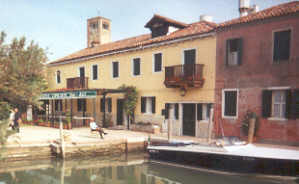
Torcello - La
Locanda Cipriani
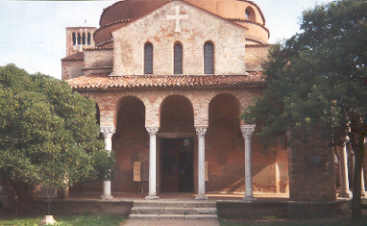
and the
Byzantine chapel
Then he also added : "But I do not see well what I can do
for you ? - I was seating in his palazzo in the armchair of
Hemingway and the holy man was asking what he could do for me !!! -
Life offers sometimes unexpected pleasures. He took me down by a
frightening 100 year old elevator hidden in the wall to the garage on
the canal where his motor boat was parked. In the garage was a wooden
hunting flat boat recalling vaguely the shape of the gondolas. The boat
was full of old painted cork decoys. A pure marvel. I took two outside
for a picture but did not dare ask if he could give me one.
The barone had an appointment in town and he drove me
back with his boat respecting the slow 20kph. He stopped at the
fondamenta di San Trovaso and explained me where to find the
duck-hunter gondoliere and we said goodbye.
|
